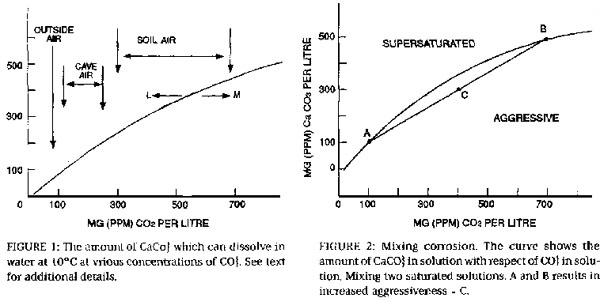The last ANDYSEZ discussed the sources of carbon dioxide and the way the gas went into and out of solution to form the weak acid called carbonic acid. I am told that there is actually no such thing but it is a convenient simplification as is the exposition which follows below. Carbonate chemistry is not simple but the ideas presented last time and developed below will give you a better understanding of what is going on ..., I hope. We are going to look at the dynamics of the carbon dioxide-water-limestone system.
To recap quickly, carbon dioxide (CO2) is found in the atmosphere at relatively low levels, at higher levels in caves which are chiefly derived from the quite high levels that occur in the soil. The more CO2 the more acid in the water in equilibrium with the gas. We are going to assume that all our limestone is made up of calcium carbonate (CaCO3) and (until Figure 2) that the water, gas and solid are all exposed to the outside, soil or cave atmospheres.
Figure 1 shows the amount of CaCO3 that can be dissolved in water containing CO2 at 10°C. You will note that it is not a straight line (it should be a smooth curve but I am not good at curves). At normal atmospheric levels of CO2 (0.03%) only about 70 milligrams (mg) per litre can be dissolved (note that one mg per litre is the same as one part per million - ppm. We will usually use ppm because it is easier to write and perhaps easier to visualise). Soil air at 10% CO2 (a very high level) when in equilibrium with water can produce a solution containing about 500 ppm of calcium carbonate. Higher levels of dissolved calcium carbonate do occur but these are associated with acids other than our "carbonic acid".

The two arrows on Figure 1 labeled "L" and "M" are the next points for consideration (L = less; M = more). When less CO2 is available, for example when the water moves from equilibrium in the soil atmosphere to a cave atmosphere, less carbonate can be held in solution as the water becomes less acid as it degasses (as when we took the top off our soda water bottle). Less acid means less carbonate able to be held in solution. The carbonate must go somewhere out of solution and thus starts forming a stalactite or something similar.
The contrary case, when more CO2 goes into solution making the water more acid (aggressive), is when caves are formed. One place where this occurs is at the soil/rock interface and this is where most limestone solution takes place (typically about 55% of the solution in any given landscape occurs there).
Why chose 10°C and what happens if it is hotter or cooler? Firstly, 10°C is near enough to the sorts of temperature at which solution takes place - at least in southern Australasia. You will have noted that when you heat water, small bubbles come out of solution long before the water boils. Hot liquids dissolve less gas and thus in more tropic climes water contains carbon dioxide and should be less aggressive than in temperate latitudes - this is in fact so. Conversely (there is always a conversely, isn't there!) in cooler climates there should be more CO2 and thus more solution - this is also true.
Why then, do we get extensive caves and other karst features in warm places? Amongst many other variables in the whole system warm, moist climates enhance biological activity (e.g. rainforests) and thus more CO2 is available to make waters more aggressive. Added to this warmer temperatures make chemical reactions, and this is one, proceed more quickly. Thus we get our best caves and karst in cool temperate and in warm, moist climates. Let's turn now to Figure 2 and learn something even more useful, fascinating and complicated. A chap called Bögli discovered a phenomenon called mischungskorrosion which we will term mixing corrosion - exactly the same and far easier to pronounce and spell. Bögli noted that if two solutions which are saturated with respect to calcium carbonate are mixed the resultant water will always be undersaturated and therefore aggressive. Consider the two solutions represented by A and B on Figure 2; they have the following amounts of CO2 and CaCO3 in solution:
ppm CO2
ppm CaCO3
Solution A 100 110 Solution B 700 510 Solution C (A+B) 400 310 Work it out in terms of mg per litre.
For CO2 100 + 700 = 800 mg in 2 litres = 400 mg per litre
For CaCO3 110 + 510 = 620 mg in 2 litres = 310 mg per litre
Now plot 400 ppm of CO2 on Figure 2 = 310 ppm of CaCO3 which is below the curve and thus is an aggressive solution.
But why is this important? Above the water table in the vadose zone it isn't particularly but beneath the water table in the phreatic zone (= phreas) it can be a very potent force in cave development. Add a water filled tube saturated with respect to carbonate - it can't form any more cave. Consider a vertical joint with water trickling down from the surface; it also has saturated water. But when they mix they are always aggressive and thus simply we have an explanation for bellholes in the roofs of caves as well as many other forms. We will explore the role of mixing corrosion further in a subsequent ANDYSEZ.